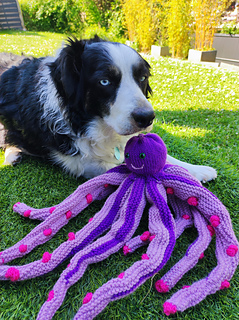patterns >  Nicole Chevalier's Ravelry Store
Nicole Chevalier's Ravelry Store
> FroggyBug Octopus
















FroggyBug Octopus
Notes en Français disponibles plus bas
Process high level description
Steps are the following
- The 8 tentacles are made in garter stitch
- they are joined in a circle (pattern V5, available from 10-JUL-2024 describes the process in 6 pictures)
- the obtained stitches are knitted in a circle, using 4 needles, forming the belly
- the top of the tentacles are then picked up and knitted in a circle, as for the belly above
- A circular row in the middle of the neck is picked up, and knitted in circle to make the head
- The suckers are just knots on a French knitting string passed inside of the tentacles.
- The smile is embroidered, then the eyes are sewed as symmetrically as possible
- the belly and the head are stuffed
- all remaining threads are hidden and well secured into the body
Techniques
• Garter stitch for the tentacle
• Purl, to manage circular garter stitch
• Button hole: yarn over, knit 2 together
• Wrap a stitch, to avoid making a hole when U-turning before the end of the row: slip the next stitch, put the yarn on the front, turn the work, slip the next stitch (which is the one slipped earlier) and knit normally
• Picking up stitches from the side: make one stitch every 2nd row
• 3-needle bind off: to join two pieces of work without sewing
• Circular knitting using double pointed needles for the belly, the neck and the head
• French knitting for the suckers
• Basic embroidering, following the stocking stitches for the smile, and for the black stars in the eyes
• Crochet magic circles for the eyes
Warning: I would need 10 to 20 hours to make this creature. If you are a total beginner or in a rush to make a soft toy, maybe save my pattern for later!
If the pattern is not clear, don’t hesitate to contact me, I’d be delighted to help you and to improve the explanation
Clarification about “French knitting”: it’s a sort of 4 stitches I-cord, made with a spool as shown in the two videos:
manual spool :
mechanic :
En Français
Processus
Les étapes sont les suivantes
- Les 8 tentacules sont tricotés au point mousse
- Ils sont joints en cercle (la version V5, disponible depuis le 10/07/2024 décrit ce process en 6 photos)
- Ce cercle est tricoté en diminuant progressivement pour former le ventre
- Les mailles du dessus des tentacules sont relevées pour tricoter le cou
- Les mailles sur un rang du cou sont relevées et tricotées en rond pour former la tête
- Des cordons de tricotin rentrent st sortent des tentacules pour former les ventouses
- Il ne reste plus qu’à broder le sourire, coudre les yeux, rembourrer la tête et le ventre, et sécuriser tous les fils à l’intérieur du corps.
Techniques
• Point mousse pour les tentacules
• Envers pour effet point mousse en tricot circulaire
• Boutonnières : Fil devant, tricoter 2m end ensemble.
• Rangs raccourcis (demi-tour avant la fin du rang) en enveloppant la dernière maille : 1 maille glissée, fil devant, tourner l’ouvrage, 1 maille glissée, tricoter normalement.
• Mailles relevées sur le bord (1 maille tous les deux rangs, soit toutes les barres de mousse)
• Mailles relevées sur un rang
• Assemblage à trois aiguilles, qui peut être remplacé par une couture simple
• Tricot circulaire pour le ventre, le cou et la tête
• Tricotin pour les ventouses
• Notions basiques de broderie, en suivant la forme en V des mailles jersey pour le sourire, étoiles pour les pupilles
• Crochet : anneau magique pour les yeux
Avertissement: La confection de cette peluche me prend de 10 à 20 heures. Si vous débutez dans le tricot, ou que vous n’avez pas trop de temps à y consacrer, je vous conseillerais de remettre ce projet à plus tard.
A propos de tricotin, c’est un genre de I-cord sur 4 mailles, fait à l’aide d’une sorte de tube surmonté de 4 clous. Pour en savoir plus, voici deux vidéos:
tricotin manuel :
tricotin mécanique :
107969 projects
stashed
58687 times
- First published: April 2020
- Page created: April 19, 2020
- Last updated: May 29, 2025 …
- visits in the last 24 hours
- visitors right now




